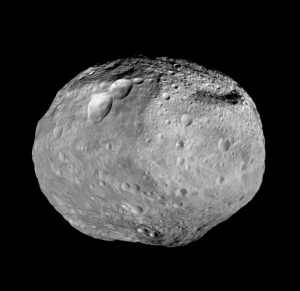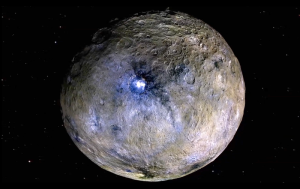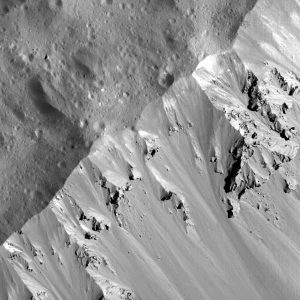Farewell to the Dawn Mission
Yesterday, NASA announced the end of the Dawn mission after the spacecraft missed communications sessions on 31st October and 1st November. Mission managers have concluded that the spacecraft has finally run out of fuel and is no longer able to keep its communications systems pointing at Earth or turn its solar panels to the Sun to recharge.
The Dawn spacecraft launched in 2007 to visit the two largest objects in the main asteroid belt, Vesta and Ceres. Although it has lost contact with Earth, the spacecraft will remain orbit around the dwarf planet Ceres for decades.
Two of Dawn’s three instruments were provided by European institutions:
- The Max Planck Institute for Solar System Research (MPS), Gottingen, Germany, provided the Framing Cameras with significant contributions by the German Aerospace Center (DLR) Institute of Planetary Research, Berlin, and in coordination with the Institute of Computer and Communication Network Engineering, Braunschweig.
- The Visible and Infrared Mapping Spectrometer (VIR-MS) was funded and coordinated by the Italian Space Agency and built by SELEX ES, with the scientific leadership of the Institute for Space Astrophysics and Planetology, Italian National Institute for Astrophysics, Italy, and is operated by the Institute for Space Astrophysics and Planetology, Rome, Italy.

In this interview (re-posted with kind permission of MPS), Dawn’s Framing Camera Lead Investigator, Dr Andreas Nathues, looks back on the eleven-year mission with many surprises, important discoveries, and unexpected twists. He also speaks about the future of asteroid research.
Over the past 11 years, the Dawn mission has investigated two bodies in the main asteroid belt, the region between the orbits of Mars and Jupiter. From July 2011 to September 2012, the spacecraft accompanied asteroid Vesta, since March 2015, it has been orbiting dwarf planet Ceres. How many other asteroids have so far been studied using space probes?
Nathues: In recent years, there have been several space missions targeting asteroids. One of the most recent ones is the Japanese mission Hayabusa 2, which reached asteroid Ryugu this June. A total of 13 bodies of this type have been investigated up close by space probes. Hayabusa 1, the predecessor of the current mission, was even able to bring tiny rock particles back to Earth. Most missions, however, were fly-bys where scientific data was collected for only a few hours. Only Dawn has explored two large objects for over a year each. And there is another difference: with the exception of Vesta and Ceres, all previously visited asteroids were fragments of larger bodies. They are irregularly shaped, comparatively small chunks. Vesta and Ceres are different from those smaller bodies.
In what respect?
Nathues: Both are very special representatives of the asteroid belt. They are the two most massive bodies there. Vesta measures about 530 kilometers in diameter, Ceres even 950 kilometers. In addition, unlike other small bodies, they have a differentiated internal structure and are composed of several different layers. Vesta and Ceres are remnants of the formation phase of Earth-like planets and have developed very differently.

Understanding this evolution and gathering insights into the formation of the solar system was one of Dawn’s main goals. What was achieved in this regard?
Nathues: Very much. Vesta and Ceres indeed play a key role in understanding how this region of the Solar System was formed. It is only through Dawn that we have secure knowledge of how both bodies are built inside and what materials make up their surface. The internal layered structure of Vesta, consisting of a metallic core, rocky mantle, and crust as well as the composition of the surface prove that this body was once hot and melted. Only in such an environment can substances of different densities easily be separated in layers. Ceres, however, does not show this detailed structure, but also there a layered structure developed, possibly even a subsurface ocean from which parts may remain until today.
What can we conclude from this with regard to their evolution?
Nathues: We believe that in its formation phase Vesta captured a lot of radioactive aluminum from the explosion of an earlier star. This radioactive material provided the heat to completely melt Vesta. Since Ceres’ interior is less evolved, it probably did not originate until several million years later, at a time when most of the radioactive aluminum had already decayed. Dawn has also taught us that apparently the place of origin is crucial. Vesta probably originated where it is found today: in the middle part of the asteroid belt. Thus, it shows a similar internal structure as the inner planets Mercury, Venus, Earth and Mars, which underwent a similar development in their early stages. Ceres’ birthplace may be much farther, in the outer regions of the Solar System. This is indicated by ammonium compounds that Dawn found on its surface. Ceres probably migrated to the asteroid belt much later.
What else did we learn about Vesta?
Nathues: One of the key findings is that certain meteorites found on Earth are indeed fragments of Vesta. They are called HED meteorites. The capital letters stand for the volcanic rocks howardite, eucrite, and diogenite. In addition, we have learned that common models of planet formation do not apply. According to these models, there should be much olivine on Vesta only about 20 kilometers beneath its surface. However, we do not find a significant amount of this rock even in the huge impact basin in the southern hemisphere of Vesta. So the olivine has to be at least 40 kilometers deep. As another surprise, we discovered carbon rich minerals. These were brought to Vesta by smaller impacting asteroids. Vesta’s entire surface was gardened over billions of years after its formation by impacts like these, so that nothing of the original surface structures have been preserved.

And Ceres?
Nathues: Ceres was the big surprise of the Dawn mission. Previously, some scientists believed it to be a rather simple body. There were theories that explained its low density with high porosity. Today we know that this is wrong. Below Ceres’ surface there are underground water and water ice reservoirs, from which a saline solution emerged to surface in the recent geological past. Traces of it can be found in the characteristic bright spots of Ceres, for example in the Occator crater, which already stood out while Dawn approached Ceres. These spots are made up of salt deposits. We believe, that the emerging water evaporated and was able to create a thin exosphere of water vapor.
In mid-2017, after a more than two-year stay at Ceres, it was discussed whether Dawn should use the remaining fuel to leave Ceres and head for a third body in the asteroid belt. Why?
Nathues: Dawn’s primary mission was successfully completed in June 2016. NASA initially extended the mission at Ceres by one year. Thereafter, there was still fuel available; Options were checked. One of these options was an asteroid of medium size (~150 km) called Adeona. The asteroid could have been reached at that time. It would have been a flyby, but still exciting. Adeona is an intriguing research object for many reasons. Among other things, one could have investigated the question whether midsized asteroids can be differentiated too, at least in part, within their interior.
NASA decided against Adeona and in favor of an extended mission at Ceres. Why?
Nathues: A decision like this is always very difficult. One option was a completely unexplored object, which of course arouses our curiosity. The other is a well-known, very exciting object without doubt, which could be examined more thoroughly. It is important to weigh what results are expected and how important they are. The risks and costs must also be taken into account. NASA concluded that the prospects at Ceres were better. An important role was played by the fact that the closest point on Ceres’ orbit around the Sun was still approaching. If Ceres emits water vapor, this process would have to be strongest there. In addition, the colleagues operating Dawn’s gamma radiation and neutron detector hoped for improved measurements of the chemical composition of Ceres’ surface.
Has this decision paid off?
Nathues: Yes. The past few months have once again exceeded all our expectations. Since June, Dawn is flying in highly elliptical orbits around Ceres, which lead the spacecraft within about 35 kilometers of the dwarf planet. We have obtained images with a resolution of less than five meters per pixel. That’s sensational!

Can the entire surface of Ceres be imaged with this resolution?
Nathues: No, not even remotely. Since three of Dawn’s four reaction wheels have failed by now, controlling the spacecraft’s orientation and aligning the antenna to communicate with Earth consumes a lot of fuel. That’s why we have focused on imaging the most important regions. Mainly we have concentrated on sections of a strip that extends from Occator crater to Urvara crater farther to the south.
What will be happening in space-based asteroid research in the next few years?
Nathues: In the near and mid future a lot, after that less. The Japanese probe Hayabusa 2 reached the asteroid Ryugu in June of this year and will even deposit three small landing units on its surface. NASA’s OSIRIS-REx mission will arrive at asteroid Bennu this December. However, both objects are no longer bodies of the asteroid belt, but so-called Near-Earth Objects, which come comparatively close to Earth. In 2022 another mission starts: NASA ‘s Psyche mission to a potential metallic asteroid of the same name, just before Lucy will be launched to visit Trojan asteroids near Jupiter. ESA, unfortunately, is not leading any mission to asteroids at this time.
If you could choose a target for an asteroid mission, which one would it be?
Nathues: My first choice would be Pallas. This asteroid is of about the same size as Vesta, but does not orbit the Sun in the same plane as the other asteroids and planets. Its orbital plane is strongly inclined. As a result, a lower number of bodies have probably impacted on Pallas since its formation; the asteroid could still be quite pristine. Unfortunately, for the same reason, Pallas is also difficult to reach: it takes a lot of energy to leave Earth’s orbital plane. My second choice would be an active asteroid. These are bodies that orbit the Sun within the asteroid belt, but show comet-like activity. A little bit like Ceres. It is conceivable that these bodies are fragments of larger objects that once existed in the asteroid belt.
For more information on MPS involvement in Dawn, please see: http://www.mps.mpg.de/en/Dawn

